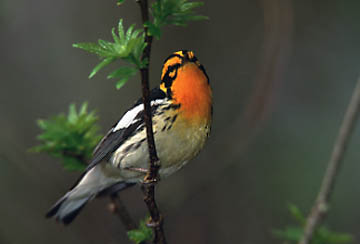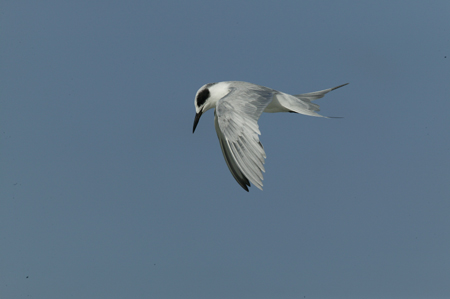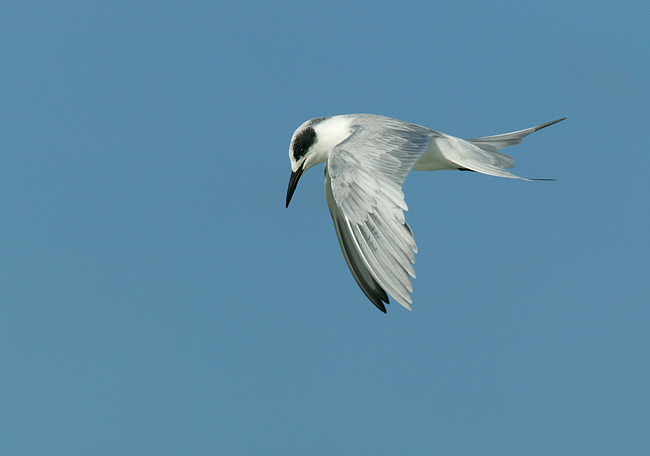Photographing
migrant warblers
is difficult. You
need to have
perfect weather
and great luck.
But when
everything is
perfect, you had
better know what
you are doing. I
skipped doing my
traditional May
warbler trips last
spring out the
frustration built
of being in the
right place at the
wrong time too
many times, of
getting to Pelee
and hearing “you
should have been
here yesterday,”
and then getting
an e-mail from
Brian Zweibel
saying “You should
have stayed at
Magee another
day!”
This year I am
trying a new
approach. I will
be leading the
first Warbler IPT
to Pelee on
the magical dates
of May 9-11 (slide
program on the
evening of May 8,
2004). Every year
that I have been
to Pelee there has
been a wave day on
one of those three
dates…. I am
leading the
Magee Marsh/Crane
Creek IPT the
following week on
May 14-16 (slide
program the
evening of May
13).
Lots of folks have
expressed interest
in joining me this
year so it would
be best to
register early.
Before you send
your deposit
check, please read
the following
carefully. Do
understand that
the presence of
warblers is
totally weather
dependent and that
rarely--in some
years, most of the
birds fly over
both of these
famed migratory
hot spots… Do
understand that
even if there is a
fallout
photographing
warblers can be
extremely
difficult. Do
understand that in
light of the above
no whining is
permitted on
Warbler IPTs
<smile> Do know
also that there is
no view-finder
sharing or
hand-holding on
warbler trips…
Do know, however,
that I will teach
you everything
that I know about
warbler
photography,
answer all of your
questions, and do
my best to get us
on some good
back-up subjects
in the event that
warblers are
scarce. This may
include Tree
(Magee) and Barn
(Pelee) Swallows,
blackbirds and
American Robins
(both locations),
Canada Geese with
goslings (Magee),
Killdeer with
chicks (Magee),
shorebirds
(Pelee), flowers
(mostly at Pelee
and nearby parks),
and frogs
(Pelee).
Pt. Pelee
(Leamington,
Ontario) Warbler
IPT May 9-11,
2004. Limit 10.
3-DAY: $829 US
funds) .
Magee Marsh/Crane
Creek (Toledo,
Ohio) IPT May
14-16, 2004.
Limit 10. 3-DAY:
$829.
To register, send
a $200 check made
out to "Arthur
Morris" to PO Box
7245, Indian Lake
Estates, FL 33855.
For additional IPT
details & general
information and
for cancellation
policies, visit:
http://www.birdsasart.com/tours.html
For additional
Warbler IPT tales,
visit:
http://www.birdsasart.com/bn49.htm
PHOTOSHOP WIZ?
Lots of folks
have asked about
my Photoshop
methods and
expertise (or
lack thereof).
The truth is, I
am getting
better. Here, I
will take you
step by step
through both my
usual procedures
and the extra
work that I did
on the image
that follows,
which is simply
the image as it
came out of the
camera
(downsized and
saved as a j-peg
for web
presentation.
You will need to
scroll down to
the see the
results.
Forster's
Tern,
Honeymoon
Island State
Park, FL
Image
copyright 2003
Arthur
Morris/BIRDS
AS ART
Canon 1Ds with
500mm mm f/4 L
IS lens & 1.4X
II
teleconverter
on tripod with
Wimberley
head.
ISO 400.
Evaluative
Metering -1/3
stop:
1/1600 sec. at
f/14.
The image above
is too dark,
especially the
black face mask,
and worse yet,
the eye cannot
be seen at
all... In
addition, there
are some serious
dust spots and
the bird is a
bit small in the
frame. Since I
create my
digital images
as Raw plus
j-peg large
files, I must
first convert
the Raw files in
Breezebrowser (www.breezebrowser.com)
so that I can
work on them in
Photoshop. Had
the image been
much darker, I
would
have changed the
exposure by
entering some
plus
compensation
during the
conversion
process, but I
knew that it
would be easy to
lighten the
overall
image using
Image/Adjust/Levels.
I converted the
image at 8-bit
and opened it in
Photoshop 7.
First, I cropped
a bit from the
rear and from
the top, wanting
the bird a bit
up in the frame
as he was
looking
downwards for a
fish. The I
cloned out the
dust spots after
enlarging the
image:
View/Actual
Pixels. Next hit
Image/Adjust/Levels
and held down
the Alt key. As
I slid the right
hand slider
slowly to the
left, the image
turned solid
black. Soon,
some bright
whitish speckles
began to
appear. This
indicated that
if I left the
slider in that
position, that
these bright
highlights would
be clipped, that
is, over-exposed
and
detail-less. As
I did not want
that in this
image, I backed
off just a bit
and released the
cursor. Next, I
did the same
with the left
hand slider and
the screen
turned totally
white. When the
first black
speckles began
to appear, I
backed off a bit
as these
speckles
represented what
would have been
underexposed
blacks. By
pulling in the
right and left
sliders the
contrast was
increased. Lastly
in Levels, I
adjusted moved
the middle
slider to the
left and
lightened the
overall image.
The eye mask was
(as expected)
still much too
dark, and the
eye was not
visible so I hit
Control + a few
times to enlarge
the image and
centered the
head in the
frame. I used
the lasso tool
to outline the
black mask, hit
Select/Feather,
entered 3 in the
pixels box, and
then hit OK.
This roughly
outlined the
mask and
softened the
edges. Next I
went back to
levels and saw
that no matter
how much that I
lightened the
black mask that
only a bit of
the eye
skin/ring was
visible, so I
cancelled levels
and went back to
the clone
tool. I then
cloned small
bits of the eye
skin/ring in a
circular pattern
in an effort to
complete the
ring. When I
was satisfied, I
added a
catch-light by
grabbing a few
white pixels
from the neck
and repeatedly
cloning the
white onto the
same spot.
Then I again
lassoed the
black mask (as
above) and
lightened the
face mask a bit
using
Image/Adjust/
Levels. I hit
View/Fit on
Screen and
voila, I could
plainly see the
eye! Next, I
boosted the
Saturation
(Image/Adjust/Hue-Saturation)
15 points as I
do with most of
my digital
images as the
color is pretty
washed out on
the images that
come right out
of the
camera. (Remember,
I loved Velvia!)
Lastly, I
boosted the
saturation of
only the blue
another 10
points by
hitting
Image/Adjust/Hue-Saturation
and then
selecting the
blues channel in
the Edit box. I
named the file
(keeping the
file number from
the camera as
part of the file
name) and hit
Save As to save
the image as a
Tiff file in the
converted folder
(along with the
converted Raw
Image).
To prepare the
image for web
viewing, I
changed the
color profile
from Adobe RGB
(1998) to sRGB
(Image/Mode/Convert
to Profile).
Then I sized the
image to 650
pixels on the
long side
(Image/Image
Size--with both
the Resample
Image and the
Constrain
Proportions
boxes checked).
Next I sharpened
the image three
times with
Unsharp Mask
(Filter/Sharpen/Unsharp
Mask---Amount:
125%, Radius:
0.2 pixels,
Threshold: 0
levels). Then
I hit File/Save
for Web,
optimized to 125
kb (the size
accepted by
NatureScapes.net),
and saved the
image as a j-peg
in my Web file.
Here is that
final image:
I am indebted to
many folks for
helping me to
improve my
Photoshop
skills: Matt
Hagadorn, Greg
Downing, Heather
Forcier, Ellen
Anon, Todd
Gustafson, Juan
Pons, Gregory
Georges, and
Tim Grey (among
others)
have been
generous with
both their time
and their
knowledge. A
man is lucky
indeed to have
such a cast of
talented friends
upon whom to
call for
Photoshop help
and guidance.
FLORIDA BIRDING
FESTIVAL
APPEARANCES
I will be
presenting a
new keynote
program (Our
National
Wildlife
Refuges: A
Photographic
Celebration)
this Thursday
(October
9, 7:30pm) at
Eckerd College
where the
Festival is
being held. I
am also doing
a How-To slide
program
entitled
"Putting Art
in Your Nature
Photography"
on Friday
(October 10,
2:45 - 5pm),
and leading an
In-the-Field
Photography
Workshop on
Saturday
morning (6:30
- 10:30 am) at
Fort DeSoto
Park. You
must register
for all
programs.
Visit the
Pinellas
County
Environmental
Foundation web
site at:
http://www.pcef.org/events-fbf.html or,
for additional
info
including the
great lineup
of speakers
and field
trips, visit:
http://www.pcef.org/fbf/Brochure.pdf
(You will need
Adobe Acrobat
to view the
pdf file.)
I will have a
booth, so if
you can make
it, be sure to
stop by and
say "Hi."


